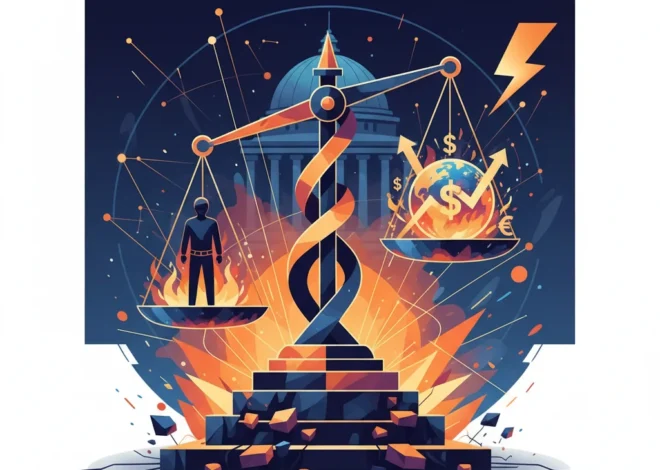
History’s Warning: Are We Ignoring the Lessons of the 1970s Banking Crisis?
In the whirlwind of modern finance, when crises strike, our minds often jump to the most recent cataclysm: the Global Financial Crisis of 2008. When Silicon Valley Bank and Credit Suisse stumbled in 2023, the comparisons were immediate and ubiquitous. But what if we’re looking at the wrong historical precedent? A short, incisive letter to the Financial Times by Martin Allen serves as a potent reminder of a ghost from Britain’s financial past: the Secondary Banking Crisis of 1973-75. It’s a crisis many have forgotten, but one whose echoes resonate with unsettling clarity in today’s economic landscape.
This wasn’t a global meltdown, but a contained fire that threatened to burn down the entire UK financial system. It was a story of deregulation, speculative mania, and a painful, inevitable collapse. By dissecting this “forgotten crisis,” we can uncover timeless lessons about the cyclical nature of risk, the dangers of chasing yield, and the critical importance of robust regulation in an ever-evolving world of finance and investing.
The ‘Go-Go’ Years: Setting the Stage for Collapse
To understand the crisis, we must first step back to the UK of the early 1970s. The economic climate was one of ambitious growth, fueled by a policy known as “Competition and Credit Control” (CCC), introduced in 1971. This sweeping deregulation was designed to stimulate the economy by removing lending ceilings and fostering competition among banks. As The National Archives note, the policy effectively unleashed a torrent of credit into the system, an era often dubbed the “Barber Boom” after then-Chancellor Anthony Barber.
This new, liberalized environment gave rise to a host of newer, more aggressive financial institutions known as “secondary” or “fringe” banks. Unlike the established, conservative clearing banks (the Barclays and Lloyds of the world), these secondary banks were specialists. They lacked a large depositor base and instead raised funds on the wholesale money markets. Freed from the old constraints, they plowed this money aggressively into higher-risk, higher-reward ventures—primarily speculative commercial property development and the booming stock market.
A classic asset bubble was born. Property values soared, stock prices climbed, and the secondary banks, leveraged to the hilt, looked like geniuses. But the foundations were built on sand. The entire model was predicated on ever-rising asset prices and the continued availability of cheap, short-term funding from the money markets.
The Domino Effect: When the Music Stopped
In late 1973, the music stopped abruptly. A confluence of factors brought the “Go-Go” years to a screeching halt. The Yom Kippur War triggered the 1973 oil crisis, sending energy prices skyrocketing and stoking rampant inflation. In response, central banks, including the Bank of England, were forced to hike interest rates dramatically to cool the overheating economy.
For the secondary banks, this was a death blow. Their funding costs on the wholesale markets exploded overnight. Simultaneously, the property market they had gambled on began to collapse as the economy soured. They were trapped in a vice: their assets were plummeting in value while their liabilities were spiraling. The first major domino to fall was London & County Securities in November 1973, which revealed a severe liquidity crisis. Panic spread through the interbank lending market like wildfire. No one knew who was exposed, and credit froze solid.
The Bank of England, fearing a systemic collapse that could take down the entire UK banking system, was forced to act. It orchestrated a massive, clandestine rescue operation known as the “Lifeboat.” In this scheme, the Bank and the major clearing banks pooled resources to provide liquidity support to the failing secondary banks, preventing a wholesale panic. The Bank of England’s own analysis highlights that this operation, while successful in averting disaster, was a costly and complex undertaking that lasted for years. The crisis ultimately led to the Banking Act of 1979, which for the first time created a formal, tiered system for bank supervision and authorization—a direct lesson learned from the chaos.
Echoes in the 21st Century: 1973 vs. 2023
While separated by half a century of innovation in financial technology, the parallels between the Secondary Banking Crisis and the regional banking turmoil of 2023 are stark. The collapse of Silicon Valley Bank (SVB) in the US offers a compelling modern comparison.
Below is a table comparing the core elements of these two crises:
| Factor | Secondary Banking Crisis (1973-75) | Silicon Valley Bank Collapse (2023) |
|---|---|---|
| Macro Environment | “Barber Boom” deregulation, easy credit policies. | A decade of near-zero interest rates and quantitative easing (QE). |
| Key Institutions | “Fringe” or “Secondary” banks with specialized, high-risk models. | A specialized regional bank heavily concentrated in a single sector (tech/VC). |
| Asset Concentration | Massive, leveraged exposure to commercial property development. | Massive, unhedged exposure to long-duration government bonds. |
| Collapse Trigger | 1973 oil shock and sharp, rapid interest rate hikes by the Bank of England. | Sharp, rapid interest rate hikes by the US Federal Reserve to combat inflation. |
| Nature of the Run | A “run” by other banks on the wholesale money market, cutting off funding. | A digital bank run by depositors, fueled by social media and mobile banking. |
| Regulatory Response | The “Lifeboat” scheme, an ad-hoc bailout by the central bank and major banks. | FDIC intervention, creation of the Bank Term Funding Program (BTFP) by the Fed. |
The parallels are undeniable. Both crises were preceded by a long period of easy money that encouraged risk-taking. Both involved specialized institutions that were heavily concentrated in a particular asset class, making them exquisitely vulnerable to a single point of failure. And most critically, both were ultimately triggered by the same catalyst: a sudden and sharp rise in interest rates that exposed the fatal flaws in their business models. As reporting on the 2023 events showed, SVB’s failure was a classic case of asset-liability mismatch in a changing rate environment—a lesson straight from the 1973 playbook.
UK Hints at Energy VAT Cut: A Lifeline for the Economy or a Risky Fiscal Gamble?
Key Differences and Modern Complexities
Of course, the analogy isn’t perfect. The world of fintech, blockchain, and globalized capital flows presents complexities unimaginable in the 1970s.
- Speed and Contagion: The run on London & County Securities was a slow-motion affair by today’s standards. The run on SVB was terrifyingly fast, executed in hours via smartphone apps and amplified by Twitter. In today’s interconnected system, financial contagion is no longer a risk; it is a certainty.
- Regulatory Framework: The post-2008 regulatory architecture (Basel III, Dodd-Frank) is far more comprehensive than the regime of the 1970s. Capital requirements are higher, and stress testing is routine. However, the 2023 crisis revealed gaps, particularly in the supervision of mid-sized banks that flew under the “systemically important” radar.
- The Rise of Shadow Banking: Much of today’s financial risk lies outside traditional banks in a vast, less-regulated “shadow banking” system of hedge funds, private equity, and other non-bank lenders. This makes tracking and managing systemic risk a far greater challenge for today’s policymakers.
Lessons for Today’s Investor and Leader
So, what can we take away from this fifty-year-old crisis? The lessons are as relevant for a day trader using a fintech app as they are for the CEO of a multinational corporation.
- For Investors: History is your best guide to risk. Understand that paradigms of “easy money” do not last forever. Be deeply suspicious of concentrated bets and be aware of interest rate risk, not just in your bond portfolio, but across the entire stock market. The phrase “this time is different” should always be a red flag.
- For Business Leaders: Stress-test your balance sheets. What does a sudden 300-basis-point rise in borrowing costs do to your business model? How diversified are your funding sources? The failure of SVB’s clients to diversify their banking relationships was a key part of the panic.
- For Policymakers: Regulatory vigilance is not a “set it and forget it” exercise. Financial innovation will always seek to outpace regulation. The balance between encouraging competition and ensuring stability is delicate and requires constant re-evaluation. The 1973 crisis proves that deregulation, without a concurrent strengthening of supervision, is a recipe for disaster.
Milan's Hidden Courtyards: A Blueprint for Finding Alpha in Today's Economy
The Secondary Banking Crisis may be a footnote in many economics textbooks, overshadowed by the larger global events that followed. Yet, its story of speculative excess, regulatory failure, and painful correction is a timeless one. It reminds us that while the technologies and terminologies of finance evolve, the fundamental human behaviors that drive booms and busts do not. By studying these echoes from the past, we can better prepare ourselves for the inevitable cycles of the future.


